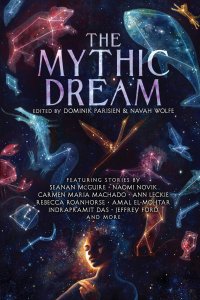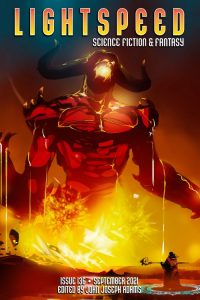Gary K. Wolfe and Rich Horton Review The Mythic Dream, Edited by Dominik Parisien & Navah Wolfe
 The Mythic Dream, Dominik Parisien & Navah Wolfe, eds. (Saga 978-1-5344-4228-3, $24.99, 368pp, hc) September 2019.
The Mythic Dream, Dominik Parisien & Navah Wolfe, eds. (Saga 978-1-5344-4228-3, $24.99, 368pp, hc) September 2019.
With two well-received anthologies already to their credit (The Starlit Wood and Robots vs Fairies) Dominik Parisien & Navah Wolfe can’t possibly believe that their idea for the third one – retellings and reshapings of world myths – is going to strike anyone as wildly innovative. Not only are there many anthologies based on the same idea (Kate Bernheimer’s xo Orpheus: Fifty New Myths is only one fairly recent example), but whole publishing programs, like the Canongate Myth series of short novels, which included work by Margaret Atwood, A.S. Byatt, and Jeanette Winterson. For that matter, an intimidating chunk of all music, art, and literature involves revisiting myths, so what new should we expect from The Mythic Dream, which brings together 18 original stories from an eclectic range of mostly younger writers? Well, one clue is The Starlit Wood, which did much the same thing for fairytales, and was full of surprises. Another is the list of writers included, eight of whom have appeared in a previous Parisien/Wolfe anthology (and three who appeared in both). Anyone familiar with original anthologies is aware that the final table of contents depends partly on which contributors came through by deadline, but the diverse range of authors included in these anthologies is in marked contrast to the largely mainstream contributors to, say, the Bernheimer anthology. Nearly half the stories are SF or involve SF elements, while only a third retain the mythological names from their source material. That source material is impressively varied, ranging from widely familiar figures like Hercules, Sisyphus, and Kali to the less-known Welsh Blodeuwedd and the rabbinic legend of the Samyaton. Just under half the stories draw their inspiration from the classical Greek myths popularized by Bulfinch, Hamilton, and your coolest elementary school teacher.
Obviously, authors dealing with myth need to recognize that not even the most familiar tales are necessarily fresh in the reader’s mind, and that not even the most powerful myth can do the story’s work for it. One of the most beautifully written stories here, Jeffrey Ford’s “Sisyphus in Elysium”, begins with the familiar work of endlessly rolling the boulder up a hill, but after a bolt of lightning shatters the boulder, Sisyphus finds himself in Elysium, where he meets his wife Merope, turning the story into a moving fable, not just of punishment, but of pride, love, and memory. By contrast, in one of the funnier takes, “Fisher-Bird” by T. Kingfisher (Ursula Vernon) approaches Hercules from the perspective of a profane and sarcastic bird offering him advice, while Naomi Novik’s “Buried Deep” looks at the tale of the Minotaur in his labyrinth from the point of view of Ariadne, presented here as a sister who seeks to protect him. It’s a rather moving reconsideration of the monstrous and an interesting take on the true role of Theseus in the tale.
In “He Fell Howling”, Stephen Graham Jones reminds us that the myth of Lycaon provided a template for many later werewolf tales, only in Jones’s version, narrated by Lycaon, instead of merely accepting his fate he finds an ironic means of gaining revenge against Zeus for his punishment. Sarah Gailey’s rustic/lyrical “Wild to Covet” retains the character name of Thetis (Achilles’s mother in the myth), but turns her into a wild girl who appears in a rural community, finds herself cornered by an unwanted prophecy, and gives birth to a son named Esau, who eventually goes off to war. In its expansive scope – covering nearly all of Thetis’s and Esau’s lives – it’s a rewardingly old-fashioned story of a woman seeking her own agency in a tale that traditionally wants to limit it. And, of course, leave it to Carmen Maria Machado to concoct a fiction more bizarre than its mythical source: in “The Things Erik Eats Before He Eats Himself”, the mythical Erysichthon, cursed with insatiable hunger, becomes Erik, a comic nightmare of consumerism who, after eating his furniture and his house, hires a guy from Craigslist to help him eat himself.
Moving further afield from the Greek classics, Amal El-Mohtar’s “Florilegia; or, Some Lies About Flowers”, revisits the story of the literal flower-child Blodeuwedd from the Mabinogion, and empowers her in a way that Alan Garner never thought of. The only story drawn from Jewish myths and legends is Leah Cypess’s “Across the River”, set in a medieval Worms plagued by a sorcerer who is killing Jews. The young narrator learns that the river behind her house is the legendary Sambatyon, across which the lost tribes of Israel supposedly fled, and when she seeks their help she learns that her own agency is more important. Finding one’s own agency, in fact, seems to be a recurring theme throughout the book, as though several contributors found inspiration in the idea of liberating figures from the myths they were trapped in. JY Yang’s “Bridge of Crows”, based on the Chinese cosmological legend of the Cowherd and the Weaver Girl (which I previously had known only from Barry Hughart’s classic Bridge of Birds), begins with a young girl struggling through a burning, hellish landscape to seek the help of a witch to free her beloved, but ends with a pledge of defiance on behalf of the corvids she befriends along the way. Rebecca Roanhorse, not surprisingly, turns to Native American sources in “A Brief Lesson in Native American Astronomy”, drawn from the somewhat Orpheus-like tale of Deer Hunter and the White Corn Maiden, about an obsessive love that tries to transcend death, but places it in a kind of cyberpunk/Hollywood future in which the recently dead can live on in “engrams” stored in the minds of their survivors. It’s a snappy, clever tale whose title contains a rather obvious but appropriate pun. This moves us toward the SF side of the ledger, which I’ll get to in a moment.
Surprisingly, only a few contributors choose contemporary settings. In addition to Machado’s tale, the lead story, Seanan McGuire’s “Phantoms of the Midway”, is a haunting, Bradbury-flavored ghost story set in a fading traveling carnival in the Midwest, evoking the tale of Persephone in a rather lovely way. Kat Howard’s “Curses Like Words, Like Feathers, Like Stories”, however, seems a deliberate critique of the tale it recounts. A young woman returning to Ireland after her great-uncle’s death finds among his papers a version of the Children of Lir story, whose ending seems false to her; another narrative voice, from the legend itself, offers a corrective, but on the whole, his tale seems more dependent on knowing its source than most of the contributions. By far the most powerful and disturbing contemporary or near-contemporary tale is Alyssa Wong’s “Live Stream”, in which a livestreaming gamer, already accustomed to fighting vicious trolls, finds her life upended by a viral video taken by a creep during a one-night stand. Of all the stories, the pattern of revenge most closely and ingeniously matches that of the myth it’s based on, the tale of Actaeon ripped apart by his own dogs after spying Artemis bathing.
That brings us to the handful of stories that reimagine their sources in purely SF terms, like the Roanhouse story. Perhaps not too surprisingly, some of these authors turn to more apocalyptic mythology, like Ann Leckie, in “The Justified”, who turns an Egyptian myth of Hathor summoned to destroy a rebellious humanity into a far-future, posthuman society set on a colony planet ruled by a paranoid autarch who summons the legendary warrior Het from a self-imposed exile to suppress the seeds of rebellion, only to find that Het has a few surprises in store. Perhaps the most darkly enjoyable post-cyberpunk tale, Indrapramit Das’s “Kali_Na”, is a far more sophisticated version of Fredric Brown’s old joke-story “The Answer”, as a newly-launched corporate AI is immediately beset by trolls, and, learning from them, transforms itself into a Kali-like VR goddess of death. The story gains a great deal from being seen through the viewpoint of a young hacker and hardware scavenger named Durga, one of the most memorable characters in the whole book. An academic historian by training, Arkady Martine draws on fragmentary Sumerian texts about the sex-and-fertility goddess Innannu and turns them into a rollicking revenge space opera in “Labbatu Takes Command of the Flagship Heaven Dwells Within“, which evokes Cordwainer Smith in its manner of telling, part archival fragments and part a crusty old sergeant retelling a legend. In “Close Enough for Jazz”, the only Silicon Valley satire here, John Chu takes the goddess Idunn, guardian of the golden apples of the Norse gods, and turns her into a young engineer for a tech startup whose main product is a kind of instant bodybuilding (or more accurately, body-shaping) product which takes the form of artificial apples. Perhaps the most manically entertaining narrative voice in the book is that of Carlos Hernandez’s “¡Ciudado! ¡Que Viene El Coco!”, told in cleverly subtitled fragments by a father in a submarine, on a NOAA mission to help clean up the Pacific garbage patch, who brings his infant son along, with the ship’s AI in a kind of surrogate nanny role. He’s plagued, at least in his own mind, by the trickster-boogeyman El Coco, and the story itself shifts not quite seamlessly from credible near-future SF into absurdist fable once we learn the baby’s head has somehow been replaced by a coconut. It’s rather a relief to see that Hernandez, along with several other contributors (Machado, Kingfisher, Roanhorse) have seen the comic potential that can erupt when those portentous myths we learned in school collide with the modern speculative tale. The Mythic Dream doesn’t lack for portents and dark moments (especially in that Wong story!), but its tales never fall into the sort of schoolyard pretentiousness that’s always a danger when trying to grapple with myths that are older and bigger than you are, and they never fail to be entertaining.
-Gary K. Wolfe
[This review and more like it in the October 2019 issue of Locus.]
The Mythic Dream is an anthology of SFnal or fantastical retellings of old myths – not exactly a new thing, but this is a fertile ground and the editors have pushed their writers to explore myths from quite a range of cultures. Carlos Hernandez‘s “¡Cuidado! ¡Que Viene El Coco!” is a truly strange story: a wild mix of the very science fictional – a man on an underwater research ship for the NOAA, a ship controlled by a sophisticated AI, runs into trouble when the AI is disabled and his daughter kidnapped – with the utterly fantastical: his daughter’s head has been replaced with a coconut, and he must chase “El Coco” (or “El Cuco”) to a mysterious island to recover it. All this is in service of the story of the protagonist’s troubled marriage, his troubled childhood, and his fears that he won’t be a good father to his daughter. This is fine work. Even better, I thought, was T. Kingfisher‘s “Fisher-Bird“, told by the wonderfully realized title character as she gets involved, somewhat against her best instincts, with a man named “Stronger” (that is, Hercules) on one of his Labors. Funny stuff, and quite sharp.
-Rich Horton
[This review and more like it in the November 2019 issue of Locus.]
Gary K. Wolfe is Emeritus Professor of Humanities at Roosevelt University and a reviewer for Locus magazine since 1991. His reviews have been collected in Soundings (BSFA Award 2006; Hugo nominee), Bearings (Hugo nominee 2011), and Sightings (2011), and his Evaporating Genres: Essays on Fantastic Literature (Wesleyan) received the Locus Award in 2012. Earlier books include The Known and the Unknown: The Iconography of Science Fiction (Eaton Award, 1981), Harlan Ellison: The Edge of Forever (with Ellen Weil, 2002), and David Lindsay (1982). For the Library of America, he edited American Science Fiction: Nine Classic Novels of the 1950s in 2012, with a similar set for the 1960s forthcoming. He has received the Pilgrim Award from the Science Fiction Research Association, the Distinguished Scholarship Award from the International Association for the Fantastic in the Arts, and a Special World Fantasy Award for criticism. His 24-lecture series How Great Science Fiction Works appeared from The Great Courses in 2016. He has received six Hugo nominations, two for his reviews collections and four for The Coode Street Podcast, which he has co-hosted with Jonathan Strahan for more than 300 episodes. He lives in Chicago.
Rich Horton works for a major aerospace company in St. Louis MO. He has published over a dozen anthologies, including the yearly series The Year’s Best Science Fiction and Fantasy from Prime Books, and he is the Reprint Editor for Lightspeed Magazine. He contributes articles and reviews on SF and SF history to numerous publications.
 While you are here, please take a moment to support Locus with a one-time or recurring donation. We rely on reader donations to keep the magazine and site going, and would like to keep the site paywall free, but WE NEED YOUR FINANCIAL SUPPORT to continue quality coverage of the science fiction and fantasy field.
While you are here, please take a moment to support Locus with a one-time or recurring donation. We rely on reader donations to keep the magazine and site going, and would like to keep the site paywall free, but WE NEED YOUR FINANCIAL SUPPORT to continue quality coverage of the science fiction and fantasy field.









best blog ı have ever seen